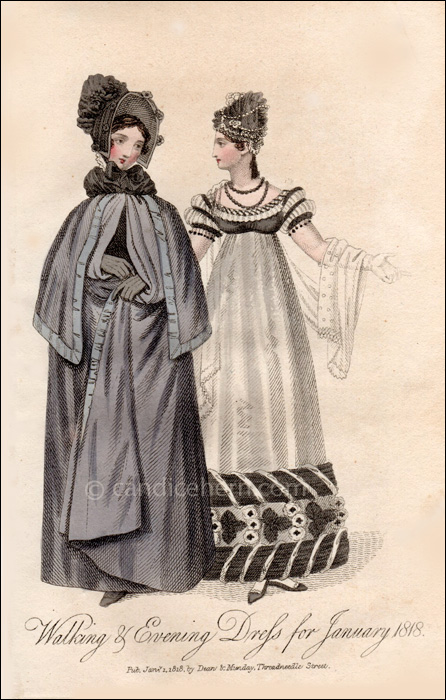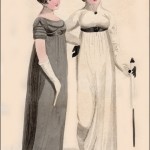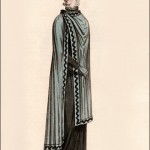Lady’s Monthly Museum, January 1818.
 “Walking & Evening Dress for January 1818.”
“Walking & Evening Dress for January 1818.”
These two ensembles represent half-mourning for Princess Charlotte, who had died two months earlier. The dress beneath the cloak on the left sounds, in the description, as though it was in the deep black of full mourning, but it can barely been seen. In other times of mourning, this magazine has stated that as the month of publication may span the time from public full mourning to public half mourning, they often try to represent both levels of mourning in their single monthly print. Or sometimes provide ways in which a dress could be altered to accommodate the periods of both full and half mourning.
The print is described in the magazine as follows:
“PROMENADE AND CARRIAGE COSTUMES. Round dress, of fine black bombazine, made high in the throat with a collar, which turns back on points considerably deeper in front, and finished with a small tassel of crape; the trimming of crimped crape, formed into small roses. The petticoat is made full, and trimmed with large satin roses, placed two together on the bias, and attached by a band of crimped crape; long sleeves made rather tight with a pointed cuff, and trimmed to correspond with the collar. Ruff, of white crimped crape, very full, and quilled in three distinct hems. For walking, or carriage costume, over this dress is worn a new and elegant wrapping cloak, made of grey mole-skin, or fine Bath coating; it descends to the feet, and is wide enough to protect the wearer from the inclemency of the weather; it is cut out on the shoulders to fit the shape, with a large military cape and hood, which folds, being made like the ladies’ chapeau bras, lined and bound with black sarsnet. Shade bonnet of fine black cane, embroidered with chenille and velvet flowers round the front; the crown, of black satin, very full, and high in the back, is made of cane and chenille like the front; the crown is surrounded with a wreath of crape and satin flowers, and tied under the chin with a broad satin ribband. Beaver gloves and shoes.
“EVENING, OR BALL DRESS. Black crape dress over a white sarsnet slip; the petticoat made full and long, trimmed very elegantly with large double rouleaus of black crape, lightly entwined with satin coqueings, inserted with a trimming of white roses and black satin leaves; this trimming is truly elegant, the transparency of the crape contrasted with the white roses gives it a light and tasteful effect; the body is made short in the waist; the bust rounded, and rather low; the under part of the body is of black crape to fit the shape, and a trimming made in small tucks of white crape to sit hollow surrounds the body, surmounted by a narrow black satin ribband chequered on crape; the sleeve is made of chequered satin ribband and white crape, tucked to sit very full, and finished with a rich bead fringe, sash of black satin ribband tied at the back; the scarf of white crape embroidered with chenille. Turban, of black crape, twisted over a very broad, and richly embroidered jet bead bandeau, carelessly tied on the left side, the end trimmed with a rich jet fringe, terminating in a jet tassel; on the right side, a crape and bead flower of a novel and elegant form. Jet necklace; white gloves and shoes.
“For these dresses, we are indebted to the taste of Miss MacDonald, of 84 Wells-street, Oxford-street.”







